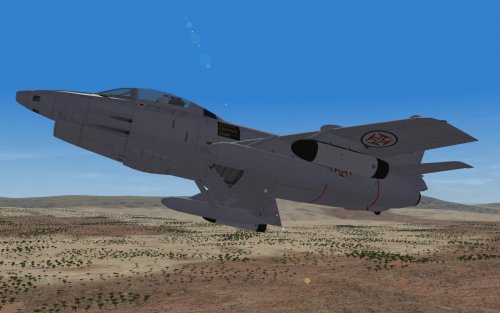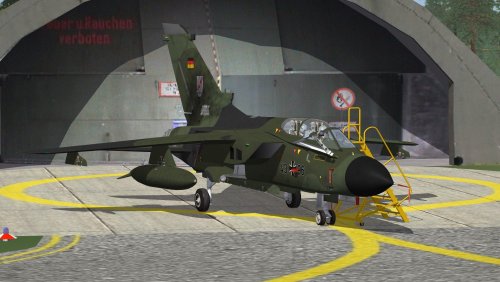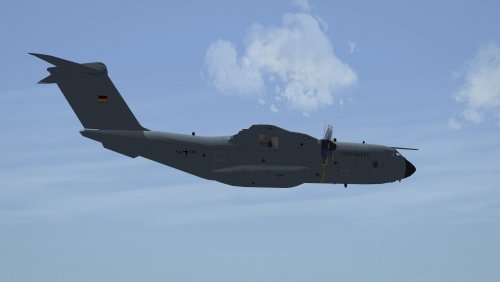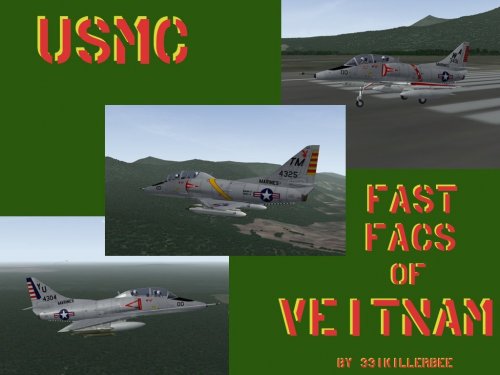
This is a Fiat G.91R pack, taking the old SFP1 mods and make them SF2 compatible.
The pack includes all three G.91R versions 1,3 & 4, with all the neccessary weapons, pilots, guns & sounds. Five missions are also included. You need to install the NATO fighters campaign for these missions and the excellent Ravenclaw_007 USAF & Luftwaffe Phantoms.
I tried to make as complete as possible, taking parts from the excellent G.91Y of ErikGen, such as the cockpit, sounds and the ejection seat.
I worked the skins (converted into jpg), the loadouts and of course the data.ini trying to do it as realistic as I could.
The real credits should go to
First and above all
- ErikGen
for make them possible.
Also
- Andriam "Kreelin" who made the original Flight Model of the G.91Rs for SPF1.
- Maurizio "NGHENGO" for the loading and hangar screens
- Spillone104 for the jet sound, photos and suggestions during beta testing of the initial G.91Y release
- Steve S for the invaluable infos about the cockpit of the initial G.91Y release
- Steve S, Soulfreak & Muesli for the amazing skins
- Ravenclaw_007 for the amazing weapons that made sense to rework the G.91R
- Viper63 for the excellent pilots
- bobrock, Soulfreak, Dave, Canadair, 76.IAP-Blackbird, Veltro2k and Nghengo as beta testers of the initial G.91Y release
Known issues
- The Attachment Position of the pylons are slighly wrong and should have been corrected. Hopefully in a later release.
- The cockpit of the G.91Y looks a bit odd, since the "Yankee" was twin-engined and I hope that someone would correct this.
- A late period ('80s) skin is missing for the Portoguese G.91R/4. I hope that someone would make a skin for it.
I had in mind to rework the G.91R for years, and finally now I managed to do it. Better late than ever.
I think most people know my love for small planes.
Remember this is a
FREEWARE

SF2 DH Sea Osprey S.1 Pack (What If...) by Cocas 10/29/2017
= For SF2 (Full-4/5 Merged Reccomended) =
*Note: you =MUST= have, as stated above have, at minimum, a Full-4 merged install, as this mod makes use of many items, most importantly, a (heavily) modified version of the stock F-4B cockpit. Therefore, it's vitally important that your game version has access to this cockpit.*
The is the release of a new "What If..." bomber by Cocas Air Factory, the DH Sea Osprey S.1 for Royal Navy, Fleet Air Arm usage. This is 4 jet engined medium bomber for use in the strike, interdiction and recon roles. The aircraft has been tested in the SF2:NA, Full-5 environment, and is carrier capable/certified/capable. Wingfold uses the Standard Animation Keystroke (tm), Shift/9.
The aircraft comes with 2 skins:
FAA1 - 1950s style, extra dark sea gray over FAA sky (1955-1962) as based aboard HMS Ocean and carries the 804 Squadron "Tiger & Sword" badge on the nose
FAA2 - 1960s style EDSG over white (1962-1970, land based) RNAS Lossimouth, 738 NAS "Black Pegasus" badge on the nose.
All markings are decals, and decal randomization is TRUE. Weapons used are all stock 3W items. Skins are in jpg format, and damage textures are DDS. All other parts (pilots, seats, etc) are supplied. More decals are supplied for the various RN CVs and several other squadrons (see "Notes" for full list).
As always, fairly easy to follow, detailed install instructions are included. So, please read them. One can find more fun reading all the Notes section as well!
Happy Landings!
Wrench
Kevin Stein
-- for Cocas Aircraft Factory --

TA-4J Skyhawk Update v2.0
=========================
Update 2.0
==========
*** SF2V required for the A-4F Cockpit, that is used here. Tested in full 5-merged installation ***
This is a complete rework of v1.0.
Things changed or added over the previous version:
- 3 Skins in higher resolution (4096x4096)
- added new Pylon/Missilerail models, aswell as some new details added via ini-edit and fakepilot
- added new droptanks (2 types of 150gal., 2 types of 300gal. and a 400gal. Tank)
- changed cockpit to a modified A-4F-cockpit
- added skids for bellylandings
Skins:
VT-7 Eagles, 1988 to 1999, NAS Meridian, Mississippi, 31 planes
VT-21 Fighting Red Hawks, 1974 to 1980, NAS Kingsville, Texas, 31 planes
VT-86 Sabrehawks, 1983 to 1989, NAS Pensacola, Florida, 11 planes
Installation
============
I recommend, you delete the files from the old version 1.0 before you install the new version. The files are at the folders below:
- Objects\Aircraft\TA-4J
- Objects\Decals\TA-4J
- Objects\Weapons\Tank300_TA-4J_VT21f
- Objects\Weapons\Tank300_TA-4J_VT21w
1. unzip to a temporary folder
2. open "Put_content_in_your_MOD folder" and do as you were told, if asked to overwrite, say 'yes' :P
3. enjoy!
If the Squadron is missing in the loadout screen, you should add the following lines in the squadronlist.ini ("<mod>\pilotdata"-folder) with XXX changed to the next free number:
[SquadronXXX]
Name=VT7
DisplayName=VT-7 'Eagles'
Nation=USN
[SquadronXXX]
Name=VT21
DisplayName=VT-21 'Fighting Red Hawks'
Nation=USN
[SquadronXXX]
Name=VT86
DisplayName=VT-86 'Sabrehawks'
Nation=USN
Credits
=======
- Thirdwire and TK for a great game and nice models.
- Fracture and Wrench for the original TA-4J Pack and Model.
- Alejandro - Escapac seat
- FastCargo - FakePilot
- OldDiego - Pilot-models
- Sounds - ???
- myself all other work (skins, decals, 3D-models of pylons, fakepilot-stuff, tanks, ini-work, etc.)
If you created the ????-marked items, please contact me, so I can add your name in the credits! If I forgot someone, please PM me too!
Thanks
======
- mue - LODViewer, which is invalueable for placing stuff!
- cocas - help learning 3D-stuff!
- denisoliveira - infos and help adjusting fakepilots to match the original models look.
- luk1978 - skids for bellylanding.
P.S.
====
If you have any problems with this skin or have suggestions and hints, feel free to PM me.
02_11_2017
SF2 TA-4F Skyhawk "Fast FACS" by 331Killerbee & Co.
This is the full package (all necessary parts included), originally created by 331Killerbee in 2008. It has been fully updated to SF2 standards, with various small changes to the aircraft and the data ini.
As with my other SF2 "fixes" for the TA-4 series, some components have been 'removed' to stop the shadow tractor beams. The FM is at the latest SF2 standard (latest patch level) Other changes include (but not limited too):
resetting all hit boxes
randomization of decals
"fake insignia" decal to activate Nation displayed name.
All weapons used are stock 3W.
Killerbee's original readme (well, actually this document!) is included for historical purposes, and it's historical background on the Fast FACs.
Have fun!!
Wrench
Kevin Stein
In late 1944, the first French unit began its transition to reconnaissance Mustangs. 26 planes were delivered.
In January 1945, the Tactical Reconnaissance Squadron 2/33 of the French Air Force took their F-6Cs and F-6Ds over Germany on photographic mapping missions.
The Mustangs remained in service until the early 1950s, when they were replaced by jet fighters.
This is F-6D version.
What's in:
- a new plane
- 7 skins
- Historical decals
- pilot, sound, weapons
Credits:
- Wolf257,Crab_02 & FastCargo for model
- Wrench for original KAW RF-51D
- Paulopanz skins, decals, screens
Operations:
- Key=10 automatic closing canopy
- Key=9 Oil Cooler Door
Installation:
- all in your main mod folder and override
Enjoy!
@paulopanz
.... made for a post war 1950 circa campaign I hope somedays someone will build up!

______________________________________________
GAF Tornado Addon for SF2 series by the GMG
______________________________________________
General:
--------
The Panavia Tornado is a family of twin-engine, variable-sweep wing multirole combat aircraft, which was jointly
developed and manufactured by Italy, the United Kingdom, and West Germany.
(source:wiki)
IMPORTANT!
This pack contains only the german versions IDS, ECR and IDS ASSTA3.1!
Due to the setup of the weapon stations, you can not change them to other nation versions!
Installation:
-------------
Unpack the files, read the GAF_Tornado_README.txt!
Drop all files into your mod folder the way they are setup in this pack.
If you are unsure about the way how mods are installed, check the knowledge base at CombatAce!
Model features:
---------------
+ All 357 serial numbers. Numbers.lst shows what aircraft reached the ASSTA upgrade.
Trainer just means, they are in reality steerable from the back also, fully combat compatible.
A "-D" behind means, the aircraft got decommissioned between 2000-2005.
"CXX-XXXX" shows the aircraft crashed by month-year.
+ Many new parts and remodeled stuff. (Including external model and cockpit)
+ Many pylons are used only for the german weapons, to make them match with launch rails and weapon locks.
+ Included are several weapons, if you have them allready, you're fine.
+ Shift+7 for Night Vision Goggles in cockpit view.
+ Shift+8 deploys stairs and covers for parking.
+ Shift+9 deploys refuel probe.
+ shift+0 opens canopy.
+ Hangar and Loading screens in two resolutions. Change in the aircraft.ini your screen aspect ratio 4:3 or 16:9.
(Two Hangar/Loading screens with -4-3 or -16-9 in Name)
Credits:
--------
Soulfreak and ravenclaw007 for their work on this, including skinning and 3D work.
Dave, sundowner and ianh755 for their work on the original files

____________________________________
A400M Addon for SF2 series
____________________________________
General:
--------
The Airbus A400M Atlas[3][4] is a multi-national, four-engine turboprop military transport aircraft. It was designed by Airbus
Military (now Airbus Defence and Space) as a tactical airlifter with strategic capabilities to replace older transport aircraft,
such as the Transall C-160 and the Lockheed C-130 Hercules.
(source:wiki)
Installation:
-------------
Unpack the files, read the A400M_README.txt!
Drop all files into your mod folder the way they are setup in this pack.
If you are unsure about the way how mods are installed, check the knowledge base at CombatAce!
Model features:
---------------
+ Paradoors are set as bomb bay
+ Paratroopers and Freight Palettes like in my C-160D
+ Counter measures are just a guess. Open the bay (Shift+8) before use.
+ Shift+7 for Formation Lights.
+ Shift+6 shuts down outer engines for taxi.
Credits:
--------
Dels for his Hercules cockpit, i borrowed for this.
____________________________________
Bo-105 PaH1 Addon for SF2 series
____________________________________
General:
--------
Since 1979, the German Army received 212 PAH anti-tank versions and 100 M-versions as liaison and observation helicopters
totaling 312 Bo 105s. The helicopter was retired from German Army service on 13 December 2016 with an 18-aircraft formation
flyby from their base in Celle.
(source:wiki)
Installation:
-------------
Unpack the files, read the Bo-105_README.txt!
Drop all files into your mod folder the way they are setup in this pack.
If you are unsure about the way how mods are installed, check the knowledge base at CombatAce!
Model features:
---------------
+ German Armyy Helo crew models
+ AN/AR 54 CM Dispensers. Never mounted, but stored for serious case. (Info by Ex PAH1 crew)
+ HOT missiles. The tubes are part of the model, as they were not jettisoned in real.
Credits:
--------
Kesselbrut for his Gazelle cockpit, i borrowed for this.

